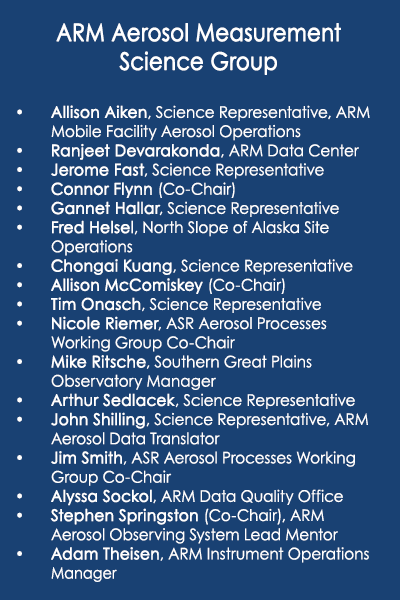A Coming Report: Aerosols, Front and Center
Published: 22 June 2020
An advisory group has recommendations for improving atmospheric aerosol sampling, measuring, and data archiving within ARM
For the past seven months, a small science advisory group has compiled recommendations on how to improve the instruments, measurement strategies, and data products needed to understand and model atmospheric aerosols.
These tiny solid and liquid particles begin as bits of pollen, soil, soot, and sea spray just microns wide that routinely loft into the air from the Earth’s surface. Aerosols have an immensely large influence on the Earth’s radiative energy budget and water cycle because they form clouds and scatter or absorb light.
Investigating aerosols is difficult. They are chemically complex and take on microscopic shapes as diverse as snowflakes. They age, swell, shrink, flatten, and change colors and chemistry according to processes not fully understood.
Despite decades as the subject of study, aerosols are a major uncertainty in making climate change predictions, says Gannet Hallar, an associate professor of atmospheric science at the University of Utah.
A Writing Project

Hallar and 16 others form the Aerosol Measurement Science Group (AMSG), which since 2015 has provided aerosol counsel to the Atmospheric Radiation Measurement (ARM) user facility, which is funded by the U.S. Department of Energy (DOE).
The AMSG is a constituent group of experts from across ARM and the atmospheric science community.
ARM’s first aerosol working group started in 1992, the year that ARM collected its first byte of data. Its first Aerosol Observing System (AOS) dates to 1996, when ARM sited an instrumented container at its Southern Great Plains (SGP) atmospheric observatory.
In November 2019, the AMSG held a strategic planning workshop to help in assembling a narrative of aerosol-science recommendations intended to update how ARM should measure aerosols.
The report is on the agenda during a June 23 session on the ARM Decadal Vision, ARM’s 10-year strategic plan, at the 2020 Joint ARM User Facility/Atmospheric System Research (ASR) Principal Investigators Meeting. The ARM/ASR meeting will take place remotely from June 23 to 26.
In a draft from early June, the report’s recommendations to ARM point to needed improvements in four main areas: sampling, data quality, measurements, and data usability.
Present and Earlier Reports
 The AMSG organizer is ARM Technical Director Jim Mather, an atmospheric scientist at Pacific Northwest National Laboratory (PNNL) in Washington state. He has reviewed drafts of the aerosol report.
The AMSG organizer is ARM Technical Director Jim Mather, an atmospheric scientist at Pacific Northwest National Laboratory (PNNL) in Washington state. He has reviewed drafts of the aerosol report.
Once he receives the final version, says Mather, “it will then be ARM’s job to work with the AMSG and the broader aerosol science community to identify actionable tasks from the report.”
The 2020 AMSG report follows a report published in early 2018, co-written by Allison McComiskey of Brookhaven National Laboratory (BNL) in New York and the now-retired Doug Sisterson of Argonne National Laboratory in Illinois. That report covered an AMSG strategic planning workshop held in February 2017 at Argonne.
The 2018 report inspired an aerosol-science action plan that Mather co-wrote that year with AMSG members Connor Flynn, now at the University of Oklahoma, and Stephen Springston of BNL. Flynn, Springston, and McComiskey are now AMSG co-chairs.
“Most of the originally identified high-priority activities have been addressed, but (the 2018 report) identified a lot of other needs,” says Mather. “We need to work with the community on priorities―along with the new issues identified in this latest report.”
The 2017 and 2019 workshops were largely about different aerosol topics, he adds―measurement issues and processes, respectively.
Most of All
McComiskey says the 2020 AMSG report contains two broad main recommendations for ARM leadership:
- Shift from continuous aerosol measurements to targeted periods of intense measurements―a recommendation recently echoed by ARM’s Cloud and Precipitation Measurements and Science Group, a parallel constituent group. (“It makes sense we are moving in the same direction,” says McComiskey.)
- Invest more in ways to capture the vertical profiles of aerosols over wider areas, beyond traditional single-point measurements. There are emerging instrument platforms miniaturized for tethered balloon systems, unmanned aerial systems, and in situ instrument arrays of small, networked, remote-sensing ground instruments.

One example of such networked instruments comes right out of McComiskey’s research backyard. She has experimental arrays of compact sensors being tested at the SGP observatory until September 2021.
Her Pilot Aerosol Microphysics Network for Targeting Climate Model Uncertainty pivots on the three-dimensional (3D) printed optical particle spectrometer (POPS). Multiples of the low-cost device, set up in wide arrays, capture data on aerosol number concentrations and size distributions.
ASR also has a group of scientists organized to identify and advance common science issues regarding aerosols.
AMSG members Nicole Riemer at the University of Illinois at Urbana-Champaign and Jim Smith at the University of California, Irvine, are co-chairs of the ASR Aerosol Processes Working Group.
Like many AMSG members, Riemer’s and Smith’s research is supported by ASR, whose science mission (improved understanding of atmospheric processes) is synergistic with that of ARM (improved observations and data for the community).
Thinking Vertically
Decades ago, says McComiskey, ARM collected data for models with much bigger grid squares than those used now. Smaller grids employed in models today focus on smaller-scale atmospheric processes.
There is also a need today to understand how aerosols are distributed vertically and across wider areas than traditional single-column ARM instruments can capture. Hence, says McComiskey, there is the need for approaches such as tethered balloons launched in tandem kilometers apart and unmanned aircraft that can fly though a wide domain of different vertical dispersions.
“There’s a lot of new technology coming online,” she says, as well as a new generation of improved retrieval algorithms. “These are examples of what we will see more of in the future.”
McComiskey is a longtime specialist in aerosols, radiative transfer, and atmospheric remote-sensing strategies. She was lead author of a chapter on ARM’s history of aerosol investigations in a chronicle of ARM’s first 20 years, published in 2016 by the American Meteorological Society.
Sampling Changes Ahead?
Not long ago, “there was a lot of talk about refining specific instruments and gaps in knowledge,” says McComiskey of the AMSG. “Now we’re trying to think in less technical terms about the measurements and more about the science perspective that will allow us to help ARM understand how they can deploy instruments and produce data products for the science ARM serves.”
In part, that requires shifting ARM aerosol measurements to “strategic sampling,” she says. “We recommend moving from comprehensive measurements running continuously through time to (deploying) larger suites of measurements during intensive operating periods.”
After all, it is resource-intensive to operate a large suite of aerosol measurements at each site, she says. “This way, there is more downtime for instruments to be maintained and calibrated in laboratory settings and more time for instrument mentors to concentrate on data quality and analysis.”
Hallar agrees. “Let’s define the most challenging instruments and run them only during intensive operating periods,” she says.
A shift to strategic sampling would allow ARM to focus on priority science objectives, says McComiskey. “We can make better measurements and more comprehensive measurements that are more attractive to the aerosol-process research community.”
An operational focus on such intensive periods would also save wear and tear, says AMSG member Jerome Fast, a PNNL scientist. “The more complex the instrument, the more likely it is that something will go wrong.”
Data Quality
AMSG recommendations also touch on ways to improve aerosol data quality.
“Data quality was on my mind as a top issue for modelers,” says Fast. “We compare model output with observations, so we want to make sure observations have as low an uncertainty as possible.”
Some types of data have a higher level of quality than others, he notes, including most measurements of optical depth and radiation.
Fast says the more problematic data sets are often based on mass spectrometry, including particle concentration and composition.
Guest instruments operated for short periods by expert users could help close such gaps in data quality, says McComiskey, who offers one example: PINE, the Portable Ice Nucleation Experiment chamber deployed at the SGP during the fall of 2019 by Naruki Hiranuma of West Texas A&M University.
“Allowing for a principal investigator with a guest instrument opens our understanding,” says Hallar, especially regarding aerosol chemistry.
Among the AMSG’s other aerosol data quality recommendations:
- Shift instrument mentor focus from the field to the lab and to time spent analyzing data. (Instrument mentors calibrate and assess ARM instruments.)
- Invest in more calibration protocols, as well as in more ARM comparisons with national and international instruments.
- Support the design of “closure experiments” that call attention to inconsistent AOS measurements and periods of poor data quality.
Improving Aerosol Measurements

Key aerosol measurement challenges remain. In this regard, the AMSG recommends:
- improving remote sensing and data sets related to aerosol absorption
- improving measurements of cloud condensation nuclei, including further testing of a flow-scanning method that boosts time resolution and accuracy
- leveraging ARM’s new aerosol humidification measurement instrumentation, including targeted data products for ARM data users
- in the long term, improving the monitoring of size-resolved aerosol chemical composition―despite, as the draft report states, “the exceedingly complex” measurement challenge of doing that.
Data Access and Usability
How easy is it for ARM users to get aerosol data? Once they do, how usable are those data?
To build a stronger base of ARM data users, the AMSG report acknowledges the core importance of data access and utility. Among the group’s recommendations in this regard:
- Bundle data into high-level products, particularly measurements that come out of the recommended new intensive operational periods.
- For easy reference for data users, publish ARM-specific studies, calibration protocols, sampling strategies, and other technical details of ARM measurement science.
- Step up the frequency of communication between instrument mentors and ARM translators. (Translators develop scientific data products from instrument data.)
- Host web conferences to raise the visibility of instrument mentors.
- Improve ARM instrument web pages and the related links to ARM’s Data Discovery browser, where users can access and order ARM data.
- Encourage principal investigators to submit data products to a pipeline of relevant value-added products. This might include, where possible, making open-source codes available to data users, who could help improve them.
Soon after the report is finished, McComiskey says she will step down as AMSG co-chair.
The group’s future, she says, will include rewriting its charter to reflect current science needs and hosting virtual aerosol-science workshops that reach beyond the usual field of experts.
Meanwhile, the AMSG and its aerosol science mission are close to her heart, says McComiskey, who before 2015 lobbied for the group to become an official part of ARM. “I’ll continue to make suggestions.”
Read Part 1 and Part 2 of a full scientist profile of McComiskey on the ASR website.
Keep up with the Atmospheric Observer
Updates on ARM news, events, and opportunities delivered to your inbox
ARM User Profile
ARM welcomes users from all institutions and nations. A free ARM user account is needed to access ARM data.


















